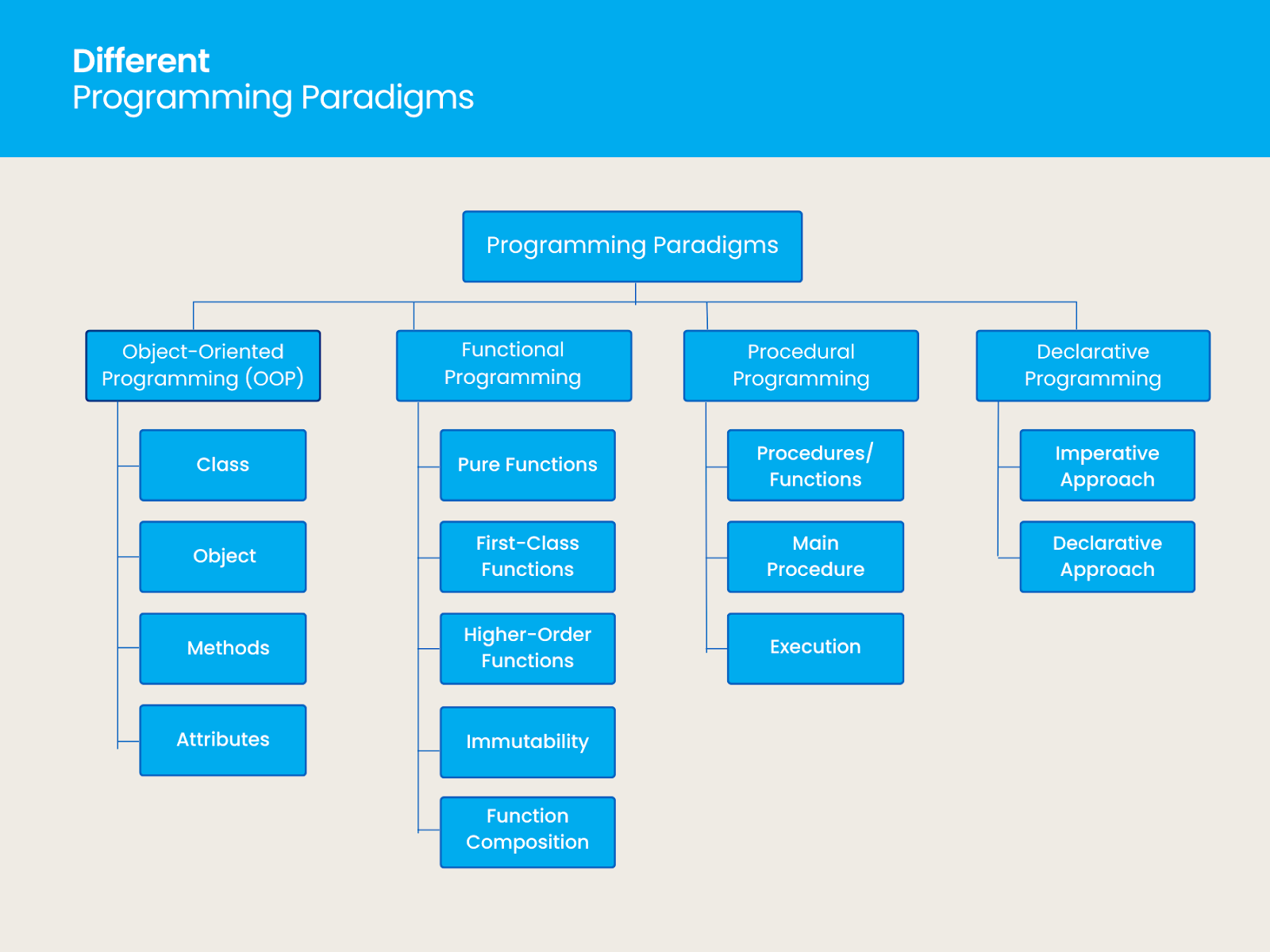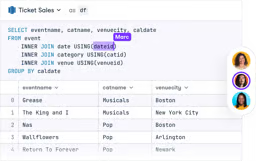Kurs
It is very important for data practitioners to understand the different types of programming paradigms. It doesn't matter if you are just starting out or looking to improve your skills; this knowledge will help you increase your productivity. In this article, we will be looking at some major programming paradigms and their importance.
Additionally, this article will also look at how these paradigms can be implemented using the Python programming language, which is an exceptionally versatile and powerful language known for its simplicity and readability.
What Are Programming Paradigms?
Programming paradigms are fundamental approaches to programming that dictate how developers conceptualize and structure their code. We can think of them as the guiding philosophies or blueprints for writing code because they offer a unique lens through which to view and solve problems.
These paradigms shape the way programmers think about and structure their code. By understanding different paradigms, you can gain new insights into writing more efficient, readable, and maintainable code.
Why is Knowing Programming Paradigms Important?
There are several reasons why you should understand programming paradigms, and we will go over them one by one here.
- Improved Problem-Solving Skills: Different paradigms offer unique ways to approach and solve problems.
- Code Understandability and Maintainability: Knowing the best paradigm for a specific task can make your code more understandable and easier to maintain.
- Ease of Learning New Frameworks: Being familiar with multiple paradigms makes it easier to learn new programming languages.
- Effective Team Communication and Collaboration: Understanding your team's paradigms can help you communicate and collaborate more effectively.
Different Programming Paradigms
In this section, we will look at the most common types of programming paradigms you will come across during your data learning journey and career. For a deeper dive into these paradigms, check out our Programming Paradigm Concepts course.
Python, as a highly versatile language, excels in supporting a variety of programming paradigms, making it a powerful tool for different programming tasks. Whether you're working with object-oriented, functional, procedural, or declarative programming, Python provides the features and flexibility needed to implement these paradigms effectively.

Different programming paradigms. Image by Author
Object-oriented programming
Object-oriented programming is part of the imperative programming family and, in line with its name, it focuses on detailing the exact steps a program must follow to achieve a specific outcome through the use of objects that encapsulate data and behavior.
To better understand, we will now take a quick look at some OOP concepts and definitions.
- Class: A class is a blueprint for creating objects by specifying their attributes and methods. It encapsulates data and the methods to manipulate that data, promoting modular and reusable code. To use cooking as an example, think of it as a recipe detailing the ingredients and steps needed to make a dish.
- Object: Objects are the fundamental building blocks of OOP. An object is an instance of a class, bundling both data and methods to operate on that data. To extend the recipe analogy, an object is the dish created from the recipe.
- Methods: Methods are actions that objects can perform. In our recipe analogy, they are the steps to make a dish. Like functions, they belong to objects and typically act on the object's data.
- Attributes: Attributes are the data stored inside an object, representing its characteristics or properties. In our recipe analogy, they are the ingredients used to make the dish.
So far, we have explored the fundamental terms in OOP using a recipe analogy. Let’s now look at an implementation use case with OOP. Imagine you are tasked with preparing various dishes, where each dish represents an object with its own properties and behaviors.
# Define a class named Dish
class Dish:
# Constructor method to initialize instances of Dish with a name and main ingredient
def __init__(self, name, main_ingredient):
self.name = name # Assign the 'name' parameter to the instance variable 'self.name'
self.main_ingredient = main_ingredient # Assign the 'main_ingredient' parameter to 'self.main_ingredient'
# Method to prepare the dish
def prepare(self):
print(f"Preparing {self.name} using {self.main_ingredient}.")
# Method to serve the dish
def serve(self):
print(f"Serving {self.name}.")
# End of class definitionThe Python code above illustrates how OOP allows you to model real-world entities with defined properties and behaviors. The Dish class serves as a blueprint for creating objects that represent different dishes. Each dish has attributes (name and main_ingredient) and methods (prepare and serve). This is how OOP promotes modularity and code reusability.
Functional programming
Functional programming is a paradigm that builds programs by applying and composing functions. This approach avoids changing states and mutable data, which leads to clearer and more predictable code.
In functional programming, you create small, reusable pieces of code that do one thing very well, and you avoid changing data directly. Let’s illustrate by looking at some key concepts.
- Pure Functions: Pure functions are the building blocks of FP. They always produce the same output for the same input and have no side effects, meaning they don't modify any external state or data.
- First-Class Function: In FP, functions are first-class citizens. They can be assigned to variables, passed as arguments, and returned from other functions.
- Higher-Order Functions: Higher-order functions take other functions as arguments or return functions as results.
- Immutability: In FP, data is immutable, meaning it cannot be changed once created. Instead of modifying existing data, new data structures are created.
- Function Composition: This process involves combining two or more functions to create a new function. It enables the construction of complex operations from simpler ones.
The code example below explores functional programming in Python.
# Pure function example
def square(x):
return x * x # Calculate square of x
# First-class function example
def cube(x):
return x * x * x # Calculate cube of x
# Higher-order function example
def apply_operation(func, num):
return func(num) # Apply func to num
# Function composition example
def add_one(x):
return x + 1 # Increment x by 1
def square_and_increment(y):
return add_one(square(y)) # Compose square and add_one
# Immutable data example
def add_to_tuple(original_tuple, new_element):
new_tuple = original_tuple + (new_element,) # Create a new tuple with new_element
return new_tuple
# Using these functions
result_square = apply_operation(square, 5)
print("Result of applying square function:", result_square)
result_cube = apply_operation(cube, 3)
print("Result of applying cube function:", result_cube)
result_composed = square_and_increment(3)
print("Result of function composition:", result_composed)
my_tuple = (1, 2, 3)
new_tuple = add_to_tuple(my_tuple, 4)
print("Modified tuple with immutability:", new_tuple)
print("Original tuple remains unchanged:", my_tuple)This example demonstrates how FP principles are applied in Python, showcasing the clarity and efficiency that these principles bring to programming. By adhering to FP’s emphasis on functions, immutability, and composition, you can build maintainable and reliable codebases, ensuring robustness in modern programming practices.
Procedural programming
This is also an imperative programming paradigm that is based on the concept of procedure calls. Procedures, also known as routines, subroutines, or functions, are a series of computational steps to be carried out. This approach emphasizes a step-by-step sequence of instructions to perform a task.
Imagine you have a recipe for baking a cake. Each step in the recipe must be followed in a specific order to achieve the final product. In procedural programming, each step in the process is represented by a procedure. These procedures are executed sequentially.
The Python code below is a good example to illustrate procedural programming.
# Function to orchestrate the process of baking a cake
def bake_cake():
# Step 1: Mix the ingredients
mix_ingredients()
# Step 2: Preheat the oven
preheat_oven()
# Step 3: Bake the cake
bake()
# Step 4: Decorate the cake
decorate()
# Function to mix ingredients
def mix_ingredients():
print("Mixing ingredients")
# Function to preheat the oven
def preheat_oven():
print("Preheating oven")
# Function to bake the cake
def bake():
print("Baking the cake")
# Function to decorate the cake
def decorate():
print("Decorating the cake")
# Call the main function to bake the cake
bake_cake()Let’s explore the above code further.
- Procedures/Functions: Each function (
mix_ingredients(),preheat_oven(),bake(),decorate()) represents a procedural step in the baking process. - Main Procedure: The
bake_cake()function calls these individual steps in sequence. It ensures that the entire process is followed correctly. - Execution: When
bake_cake()is called, it executes each step in the order specified, much like following a recipe.
Declarative programming
Unlike with both object-oriented programming and procedural programming, in declarative programming, you focus on specifying the desired outcome for your data. This approach avoids outlining the exact steps to achieve it.
Imagine you are at a restaurant. You simply place an order by specifying what you want to eat. Detailed instructions on how the chef should prepare the meal are not provided. The chef takes care of the cooking process and delivers the desired dish to you. This is what declarative programming is all about!
We will be illustrating two distinct approaches in the code:
- Imperative Approach: This section will demonstrate explicit control flow description. It will involve iterating over a list, checking each number, and appending even numbers to a new list.
- Declarative Approach: In the subsequent part, the code will employ list comprehension to achieve the same result. Here, you will specify what you want (a list of even numbers) without detailing the steps to achieve it. Python will manage the iteration and conditional checking automatically in the background.
Let’s see how these concepts can be translated into practical examples using Python.
# Imperative approach
# Define a list of numbers from 1 to 10
numbers = [1, 2, 3, 4, 5, 6, 7, 8, 9, 10]
# Initialize an empty list to store even numbers
even_numbers = []
# Iterate over each number in the 'numbers' list
for number in numbers:
# Check if the current number is even
if number % 2 == 0:
# If the number is even, append it to the 'even_numbers' list
even_numbers.append(number)
# Print the list of even numbers
print(even_numbers)
# Declarative approach
# Use a list comprehension to create a new list of even numbers
# The list comprehension iterates over each number in 'numbers' and includes the number in the new list if it is even
even_numbers = [number for number in numbers if number % 2 == 0]
# Print the list of even numbers
print(even_numbers)Python offers declarative styles, especially through list comprehensions. In contrast, other languages exist where declarative programming is more prevalent or even the primary paradigm. A few programming language examples are SQL, HTML, and CSS.
Summary table
To wrap this up, let's take everything we know into a handy reference table.
|
Programming Paradigm |
Description |
Key Concepts |
Advantages |
|
Object-oriented Programming |
Uses objects to represent data and methods. |
Class |
Promotes modularity and reusability |
|
Functional Programming |
Builds programs using functions. |
Pure Functions |
Leads to clearer and more predictable code |
|
Procedural Programming |
Based on procedure calls, sequential steps. |
Procedures/Functions |
Simple and easy to understand |
|
Declarative Programming |
Specifies the desired outcome, not steps. |
Outcome-focused |
Focuses on what to achieve rather than how |
Learn More About Programming
Understanding programming paradigms is just the beginning. As you continue your journey, exploring different paradigms will deepen your understanding. Not just that, it will also enhance your ability to solve complex problems efficiently. Each paradigm offers unique perspectives. These perspectives and tools can be incredibly powerful when applied correctly.
Now that you have grasped these fundamental concepts, here’s how you can leverage this knowledge to propel your data science journey:
- Experiment with Different Paradigms: Don’t be afraid to try out various paradigms. Identify the ones that resonate with you and tackle the problem from different angles.
- Practice Consistently: The best way to solidify your understanding is through consistent practice. Look for online coding challenges and exercises that specifically target different paradigms.
- Build Your Portfolio: Create data science and AI projects using different paradigms to strengthen your practical skills and showcase your abilities to potential employers.
Practice with DataLab
DataLab is a great platform for practicing different programming paradigms. With DataLab, you can switch between AI-generated code and a fully-featured notebook view, ensuring you can review, tweak, and extend your code confidently. This flexibility makes it perfect for applying object-oriented, functional, procedural, and declarative programming concepts.
What is more, DataLab's connection to various data sources and prepacked sample datasets offer opportunities to practice and hone your skills. Its built-in reporting features allow you to create live-updating reports easily, ensuring your findings are always current and shareable.
DataLab
Skip the installation process and experiment with data science code in your browser with DataLab, DataCamp's AI-powered notebook.

Additional Resources
To further enhance your learning and project work, you might find these resources helpful: 60 Python Projects for All Levels of Expertise and 7 AI Projects for All Levels. These projects, like those you can create and manage in DataLab, provide practical, hands-on experience that is crucial for deepening your understanding and skills.
If you want to practice advanced topics like recursion in functional programming and class inheritance in procedural programming, take the Introduction to Programming Paradigms course, which will make you a pro at writing modular code.
Remember, the path to becoming a professional in the data science space is a continuous learning process. Embrace the challenges and celebrate your progress.
Experienced data professional and writer who is passionate about empowering aspiring experts in the data space.
Frequently Asked Questions
Do I need to learn all programming paradigms to become a data scientist?
While learning all paradigms is beneficial, it’s not essential. You can focus on the commonly used ones, like OOP and FP.
How can I decide which paradigm to use for my data science project?
You can start by understanding the nature of your project and the type of data you’re working with. If you are dealing with complex objects and relationships, OOP might be a good fit.
Which paradigm is the best for data science?
There is no best paradigm. The optimal choice depends on the problem you are solving.
Can procedural programming be combined with other paradigms?
Yes, many modern programming languages, including Python, support combining paradigms like OOP and FP.
How long will it take to master programming paradigms?
There’s no specific timeframe. It depends on your prior programming experience and the depth of understanding you aim for.


